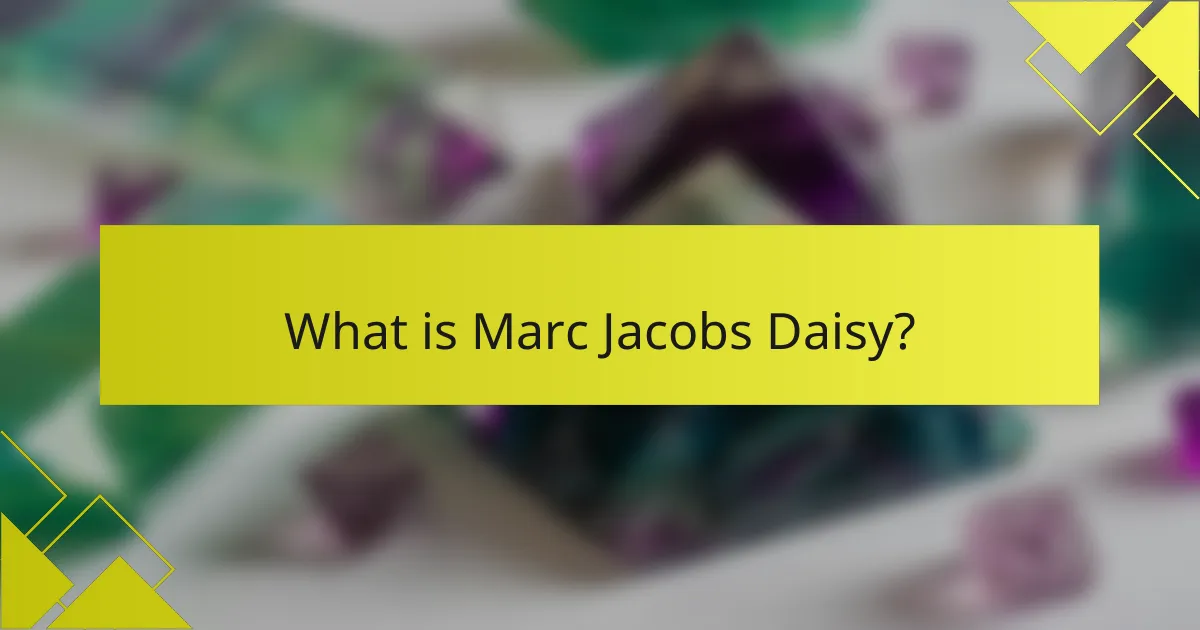
What is Marc Jacobs Daisy?
Marc Jacobs Daisy is a popular fragrance created by the fashion designer Marc Jacobs. It was launched in 2007 and has since become a signature scent for many. The fragrance is characterized by its floral and fruity notes. Key ingredients include wild strawberries, violet leaves, and jasmine. The scent is designed to evoke a sense of youthfulness and playfulness. Its packaging features a whimsical bottle adorned with daisies. This design reflects the light-hearted nature of the fragrance. Marc Jacobs Daisy has received positive reviews for its fresh and uplifting aroma.
How did Marc Jacobs Daisy become a popular fragrance?
Marc Jacobs Daisy became a popular fragrance due to its unique blend of floral and fruity notes. Launched in 2007, it quickly resonated with consumers. The fragrance features notes of wild strawberry, violet leaves, and jasmine. Its appealing scent profile attracted a diverse audience. The iconic bottle design, resembling a daisy flower, also contributed to its popularity. Marketing campaigns featured vibrant visuals and youthful themes. Positive reviews and word-of-mouth further boosted its reputation. Over the years, it has remained a best-seller in the fragrance market.
What are the key notes that define Marc Jacobs Daisy?
The key notes that define Marc Jacobs Daisy are wild strawberry, violet leaves, and jasmine. These notes create a fresh and floral scent profile. The wild strawberry adds a fruity sweetness. Violet leaves provide a green, crisp element. Jasmine contributes a soft floral touch. Together, these notes evoke a youthful and vibrant essence. Marc Jacobs Daisy is often described as light and airy, making it suitable for everyday wear.
What distinguishes Marc Jacobs Daisy from other fragrances?
Marc Jacobs Daisy is distinguished from other fragrances by its unique blend of floral and fruity notes. It features top notes of wild strawberry and violet leaves, which create a fresh and playful scent. The heart notes include gardenia and jasmine, adding a soft, feminine touch. Base notes of musk and vanilla provide warmth and depth. The fragrance is known for its youthful and vibrant character. Its iconic bottle design, adorned with oversized daisies, also sets it apart visually. This combination of scent and aesthetics contributes to its popularity among consumers.
What visual aesthetics are associated with Marc Jacobs Daisy?
Marc Jacobs Daisy is associated with a youthful and whimsical visual aesthetic. The design features a playful floral motif, often incorporating daisies in its packaging and bottle design. The color palette typically includes soft pastels, such as pinks and whites, which evoke a sense of freshness and femininity. The bottle itself has a distinctive shape, resembling a flower with its cap adorned with oversized petals. This aesthetic aligns with themes of innocence and joy, appealing to a younger demographic. Overall, the visual elements create a light-hearted and approachable brand image.
How does the bottle design reflect the fragrance’s essence?
The bottle design of Marc Jacobs Daisy reflects the fragrance’s essence through its playful and whimsical aesthetic. The floral cap symbolizes the fresh and vibrant notes of the fragrance. The rounded shape of the bottle conveys softness and femininity, aligning with the scent’s light and airy character. The use of bright colors enhances the joyful and youthful vibe of Daisy. The transparent glass showcases the light pink liquid, emphasizing purity and freshness. Overall, the design elements work together to encapsulate the cheerful and floral nature of the fragrance.
What role does packaging play in the overall aesthetic appeal?
Packaging significantly influences the overall aesthetic appeal of a product. It serves as the first point of visual contact for consumers. Attractive packaging can enhance the perceived value of the product. For example, luxury brands often use high-quality materials and unique designs to create an impression of exclusivity. The colors and graphics on the packaging contribute to brand identity and recognition. Research indicates that 70% of purchasing decisions are made at the point of sale, highlighting packaging’s critical role. In the case of Marc Jacobs Daisy, the floral and whimsical design reflects the fragrance’s essence, enhancing consumer attraction. Therefore, effective packaging not only protects the product but also elevates its aesthetic appeal.
What is the price range for Marc Jacobs Daisy?
The price range for Marc Jacobs Daisy typically falls between $80 and $100 for a standard 3.4 oz bottle. This pricing can vary based on retailers and special promotions. Online platforms and department stores often list similar price points. Seasonal sales may also affect the cost, occasionally offering discounts. The fragrance’s popularity contributes to its consistent pricing. Retailers like Sephora and Ulta frequently stock this product within the stated range.
How does the price of Marc Jacobs Daisy compare to similar fragrances?
The price of Marc Jacobs Daisy is generally in the mid-range compared to similar fragrances. Most comparable fragrances, such as Chloe Eau de Parfum and Dolce & Gabbana Light Blue, are priced similarly, typically between $70 and $100 for a standard bottle. Marc Jacobs Daisy often retails for around $85 for a 3.4 oz bottle, placing it within this price range. Additionally, seasonal promotions can affect pricing, making it competitive with similar offerings. Retailers often list Daisy at prices that align closely with other designer fragrances, reinforcing its position in the market.
What factors influence the pricing of Marc Jacobs Daisy products?
The pricing of Marc Jacobs Daisy products is influenced by brand positioning, production costs, and market demand. Brand positioning reflects Marc Jacobs’ status as a luxury brand, which elevates the perceived value. Production costs include materials, labor, and packaging, impacting the final retail price. Market demand fluctuates based on trends and consumer preferences, affecting pricing strategies. Seasonal releases and limited editions can also drive prices higher due to exclusivity. Additionally, marketing efforts and collaborations can enhance brand visibility, influencing consumer willingness to pay. Overall, these factors collectively shape the pricing strategy for Marc Jacobs Daisy products.
What is the user experience like with Marc Jacobs Daisy?
The user experience with Marc Jacobs Daisy is generally positive. Many users describe the fragrance as fresh and floral. It is often noted for its lightness, making it suitable for everyday wear. The longevity of the scent is appreciated, with many reporting it lasts throughout the day. Users also enjoy the unique packaging, which adds to the overall aesthetic appeal. Additionally, the fragrance is frequently praised for its versatility, suitable for both casual and formal occasions. Reviews indicate that the scent garners compliments, enhancing the overall experience. Overall, the user experience reflects satisfaction with both the fragrance and its presentation.
How do users describe the longevity and sillage of Marc Jacobs Daisy?
Users generally describe the longevity of Marc Jacobs Daisy as moderate. Many report that it lasts around 4 to 6 hours on the skin. The sillage is often characterized as soft and subtle. Users note that it does not project strongly but leaves a pleasant trail. Some describe it as perfect for casual wear. Overall, the fragrance is appreciated for its lightness. This aligns with user reviews across fragrance forums and retail sites.
What are common user sentiments regarding the fragrance’s appeal?
Common user sentiments regarding the fragrance’s appeal are largely positive. Many users appreciate its fresh and floral scent profile. The fragrance is often described as light and youthful. Users frequently mention its versatility for both day and evening wear. Longevity is another aspect that users highlight positively. Many find that it lasts several hours without fading. The packaging also garners praise for its aesthetic design. Overall, users express satisfaction with the fragrance’s overall experience.
How does Marc Jacobs Daisy fit into the broader fragrance market?
Marc Jacobs Daisy fits into the broader fragrance market as a popular choice among floral fragrances. Launched in 2007, it quickly gained recognition for its youthful and fresh scent profile. The fragrance is characterized by notes of wild strawberry, violet leaves, and jasmine. This combination appeals to a demographic seeking light and playful fragrances.
In the competitive landscape, Marc Jacobs Daisy stands out due to its unique packaging and branding. The whimsical bottle design features a daisy cap, enhancing its visual appeal. The price range of Marc Jacobs Daisy is positioned as accessible luxury, typically retailing between $80 and $100 for a 3.4 oz bottle.
This pricing strategy allows it to attract both younger consumers and established fragrance enthusiasts. Sales data indicates that Daisy consistently ranks among the best-selling women’s fragrances in the United States. Its success contributes to Marc Jacobs’ overall brand presence in the fragrance market.
What trends in the fragrance industry does Marc Jacobs Daisy exemplify?
Marc Jacobs Daisy exemplifies the trend of youthful, floral fragrances in the industry. This fragrance targets a younger demographic with its light and fresh scent profile. It features notes of wild strawberries, violet leaves, and jasmine, appealing to those seeking playful and vibrant aromas. The packaging design, with its whimsical flower cap, aligns with the trend of visually appealing and Instagram-friendly products. Additionally, Daisy reflects the increasing demand for eco-friendly and sustainable practices, as the brand emphasizes responsible sourcing and production. Overall, it showcases how modern fragrances combine aesthetic appeal, targeted marketing, and sustainability to resonate with contemporary consumers.
How do marketing strategies impact the perception of Marc Jacobs Daisy?
Marketing strategies significantly influence the perception of Marc Jacobs Daisy. Targeted advertising creates a strong brand image associated with luxury and femininity. Social media campaigns engage potential customers and enhance brand visibility. Collaborations with influencers amplify the fragrance’s appeal to younger demographics. Seasonal promotions and limited editions create urgency and exclusivity. Public relations efforts shape the narrative around the product, reinforcing its desirability. The overall marketing approach positions Marc Jacobs Daisy as a must-have fragrance in the competitive market.
What practical tips can enhance the experience of using Marc Jacobs Daisy?
To enhance the experience of using Marc Jacobs Daisy, apply the following practical tips. First, layer the fragrance on pulse points like wrists and neck for optimal scent diffusion. This technique allows the fragrance to interact with body heat, enhancing its projection. Second, consider applying a fragrance-free moisturizer before use. This can help the scent last longer on the skin. Additionally, store the perfume away from direct sunlight and heat to maintain its integrity. This preserves the fragrance’s original scent profile. Lastly, experiment with combining Daisy with other scents for a personalized fragrance experience. This can create a unique olfactory signature that reflects individual preferences.
Marc Jacobs Daisy is a popular floral and fruity fragrance launched in 2007, known for its youthful and playful scent profile featuring key notes like wild strawberries, violet leaves, and jasmine. The article explores the fragrance’s visual aesthetics, highlighting its whimsical bottle design adorned with daisies, and discusses its price range, typically between $80 and $100 for a 3.4 oz bottle. Additionally, user experiences are examined, noting positive sentiments regarding the fragrance’s lightness, longevity, and versatility, as well as its position within the broader fragrance market and current industry trends.



